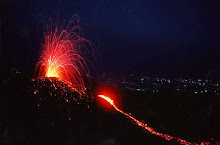Ball, Jessica. "Mount Etna - Italy." Geology.com. 23 Mar 2009 http://geology.com/volcanoes/etna/.
"Etna."Encyclopedia of Earthquakes and Volcanoes. New ed. 2001.
"Etna." Global Volcanism Program. 23 Mar 2009 http://www.volcano.si.edu/world/volcano.cfm?vnum=0101-06=.
"Mount Etna." Internet Geography. 23 Mar 2009 http://www.geography.learnontheinternet.co.uk/topics/etna.html.
"Mount Etna Italy." 25 Mar 2009 http://www.sveurop.org/gb/articles/articles/etna.htm.
Seach, John. "Mt. Etna." Volcano Live. 23 Mar 2009 http://volcanolive.com/etna.html.
"Sicily's Mount Etna erupts, no danger to residents." Thomson Reuters Sep 4, 2007 27 Mar 2009 http://www.reuters.com/article/environmentNews/idUSL0466082420070905.
How tall is Mount Etna?
Monday, March 30, 2009
Wednesday, March 25, 2009
Information on Mount Etna
Mt. Etna is a type of Shield Volcano. It is formed in Sicily, Italy. Etna formed by two continental plates colliding. More specifically, the Eurasian Plate overriding the African Plate. A few months ago, Mt. Etna erupted. (November 13, 2008) Mount Etna stands at about 3330 meters, and has roughly 5 fissures cracked open on it's surface. It's circumfrence is over 90 miles. In the past three thousand years, Etna has erupted around 190 times. Many other volcanoes are in Italy. In the past hundred years, the only volcanoes near Etna that have erupted are Stromboli and Vesuvius. Most of Etna's eruptions are non-destructive. The VEI (Volcanic Explosivity Index) is usually only 1 or 2. The lava is basaltic, and the damage caused from it can be costly.
Subscribe to:
Comments (Atom)
